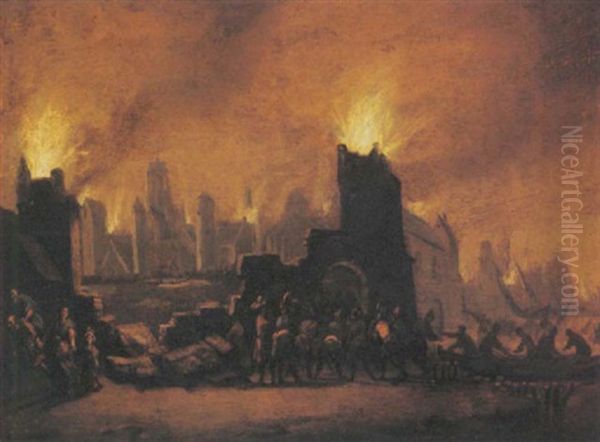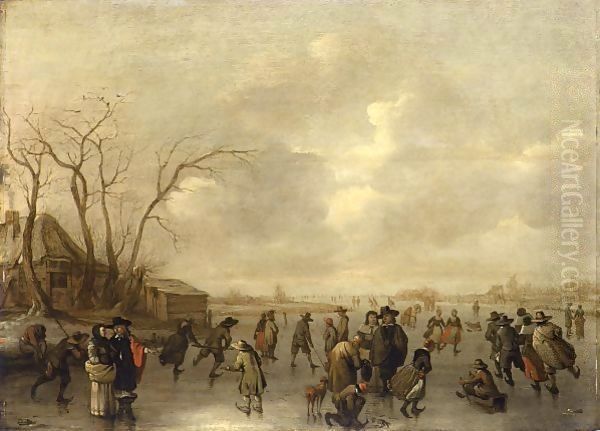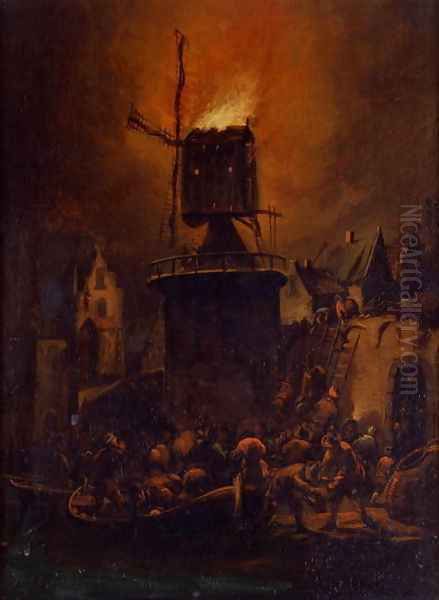Adriaen van der Poel stands as a notable figure in the rich tapestry of Dutch Golden Age painting. Active during the 17th century, a period of extraordinary artistic flourishing in the Netherlands, Van der Poel carved out a niche for himself with his evocative landscapes, detailed genre scenes, and particularly, his dramatic depictions of fires. While perhaps not possessing the widespread international fame of contemporaries like Rembrandt van Rijn or Johannes Vermeer, his work offers invaluable insights into the daily life, environment, and even the anxieties of his time. His paintings serve as visual documents, capturing everything from tranquil domestic interiors to the terrifying spectacle of urban conflagrations.
Early Life and Artistic Formation
The precise details of Adriaen van der Poel's birth are subject to some scholarly debate, as is common for many artists of this period. However, the prevailing consensus places his birth in Delft around 1621. He was the son of Lieven Ariensz. van der Poel, who is recorded as a goldsmith. Growing up in Delft, a prosperous city renowned for its pottery, breweries, and vibrant artistic community, would undoubtedly have provided a stimulating environment for a young, aspiring artist. Delft, during Adriaen's youth, was home to or would soon nurture talents such as Carel Fabritius, Nicolaes Maes, and the aforementioned Vermeer.
The identity of Adriaen van der Poel's teacher is not definitively documented. However, art historians have often suggested that he may have studied with Esaias van de Velde, a versatile artist known for his landscapes, genre scenes, and battle pieces. Esaias van de Velde was a pioneer of Dutch realist landscape painting, moving away from the more artificial, mannerist styles of the previous generation. If this tutelage occurred, it would have instilled in Van der Poel a keen eye for naturalistic detail and an appreciation for capturing the Dutch countryside. Another potential influence, particularly for his genre interiors, might have been Cornelis Saftleven, a Rotterdam-based painter known for his peasant scenes and barn interiors, often imbued with a rustic charm. Adriaen's brother, Egbert van der Poel, was also a painter, and they shared an interest in similar subjects, particularly fire scenes.

By 1650, Adriaen van der Poel was enrolled in the Guild of Saint Luke in Delft. Membership in the guild was essential for artists wishing to practice their trade professionally, take on apprentices, and sell their work. This indicates that by this time, he was an established and recognized painter. His early works likely focused on the genre scenes and landscapes that were popular with the burgeoning Dutch middle class, who sought art that reflected their own lives and surroundings rather than mythological or overtly religious themes favored in other parts of Europe.
Signature Themes: Fire, Interiors, and Landscapes
Adriaen van der Poel's oeuvre is characterized by a few recurring and distinctive themes, each handled with a specific sensibility that defines his artistic contribution. He was a painter of everyday life, but also of extraordinary events, demonstrating a versatility that catered to diverse tastes.
Depictions of Fire and Disaster:
Perhaps Van der Poel's most famous and dramatic works are his depictions of fires, particularly night scenes. He excelled at capturing the chaotic energy, the lurid glow of flames against the darkness, and the desperate activity of people attempting to combat the blaze or flee from it. These paintings were not merely sensational; they tapped into a real fear in tightly packed wooden cities of the 17th century.
A pivotal event that profoundly impacted Delft and its artists, including Van der Poel, was the catastrophic Delft Thunderclap (Delftse Donderslag) on October 12, 1654. A gunpowder magazine exploded, devastating a significant portion of the city, killing hundreds, including the promising painter Carel Fabritius, a student of Rembrandt. Adriaen van der Poel painted numerous versions of this event and its aftermath, such as "A View of Delft after the Explosion of 1654." These works serve as historical records, albeit artistically interpreted, of the disaster. His paintings often show the smoldering ruins, the dazed survivors, and the sheer scale of destruction. His brother, Egbert van der Poel, also became renowned for his many depictions of this same event.
In his fire scenes, Adriaen often placed the fire prominently, making it the central, almost visceral focus of the composition. This contrasts somewhat with another master of nocturnal light, Aert van der Neer, who often integrated fires or moonlight into broader, more atmospheric landscape compositions. Van der Poel's approach was often more direct and narrative, focusing on the human drama unfolding amidst the flames. Works like "The Burning of Troy," though a historical subject, allowed him to explore the dramatic potential of fire on a grand scale, a theme also tackled by artists like Jan Brueghel the Elder in earlier periods, albeit with a different stylistic approach.
Genre Scenes and Domestic Interiors:

Alongside these dramatic portrayals, Van der Poel was a skilled painter of genre scenes, particularly rustic kitchen interiors and barn scenes. These paintings offer a glimpse into the humbler aspects of 17th-century Dutch life. Works such as "A Cottage Kitchen" or "Peasants by a Fire in a Barn" are filled with carefully observed details: cooking utensils, domestic animals, humble furnishings, and peasants engaged in daily chores or moments of rest.
These interiors are often characterized by a warm, earthy palette and a play of light and shadow, sometimes illuminated by a hearth fire or light streaming through a doorway. They share affinities with the work of artists like Adriaen Brouwer, Adriaen van Ostade, and Isack van Ostade, who specialized in peasant genre scenes. However, Van der Poel's figures, while rustic, often lack the boisterousness or caricature found in some of Brouwer's or Steen's tavern scenes, leaning towards a more straightforward depiction of rural life. The meticulous rendering of objects in these scenes reflects the Dutch preoccupation with realism and the tangible world.
Landscapes and Coastal Views:
Van der Poel also produced landscapes, including river scenes, beach scenes, and winter landscapes. These works demonstrate his ability to capture the specific atmospheric conditions of the Dutch environment – the flat horizons, the expansive skies, and the interplay of light on water. His coastal scenes often feature fishermen, boats, and the daily activities associated with seaside communities. These are in line with the broader tradition of Dutch landscape painting established by artists like Jan van Goyen, Salomon van Ruysdael, and later refined by Jacob van Ruisdael. His moonlit scenes, like his fire scenes, showcase his interest in varied light effects, a fascination shared by Aert van der Neer.
Stylistic Characteristics
Adriaen van der Poel's style is rooted in the Dutch realist tradition. He generally avoided the grand, idealized international Baroque style that was prevalent in Flanders with artists like Peter Paul Rubens or Anthony van Dyck. Instead, he, like many of his Northern Netherlandish contemporaries, focused on the observable world, rendered with attention to detail and texture.
His compositions are typically well-structured, guiding the viewer's eye through the scene. In his fire paintings, the dramatic use of chiaroscuro – strong contrasts between light and dark – is a key feature, heightening the sense of drama and highlighting the destructive power of the flames. The flickering light illuminates faces, buildings, and smoke, creating a dynamic and often unsettling effect.

In his genre interiors, the lighting is often more subdued, creating a sense of intimacy and domesticity. He paid close attention to the rendering of different materials – the gleam of copper pots, the roughness of wooden beams, the texture of fabrics. This tactile quality was highly valued by Dutch patrons.
His figures are generally sturdy and unidealized, fitting naturally into their settings. While not always the primary focus, they are integral to the narrative of his scenes, whether they are actively fighting a fire or quietly going about their chores. He also occasionally employed the grisaille technique (monochromatic painting, usually in shades of grey), a method used by artists like Jan van Goyen for its speed and atmospheric effects, though Van der Poel's use was perhaps less extensive.
Life After Delft: Leiden and Later Career
Sometime after the 1654 Delft explosion, possibly due to the devastation or seeking new opportunities, Adriaen van der Poel moved to Leiden. He is recorded as joining the Guild of Saint Luke in Leiden in 1655, indicating his intention to continue his artistic career in this prominent university city. Leiden was another important artistic center, home to figures like Jan Steen (who also spent time in Delft and The Hague) and the young Gerrit Dou, one of Rembrandt's first pupils who founded the Leiden "fijnschilders" (fine painters) school.
In Leiden, Van der Poel continued to paint the subjects for which he was known. His production of fire scenes, including further depictions of the Delft disaster, remained a significant part of his output. He also continued with his genre interiors and landscapes. The consistent demand for these themes suggests a ready market for his work.
His style likely remained relatively consistent throughout his career, refining his techniques rather than undergoing radical transformations. This was not uncommon for many Dutch painters who found a successful formula and a receptive audience for their particular specializations. He continued to work productively in Leiden for several decades.
Contemporaries and Artistic Context
To fully appreciate Adriaen van der Poel's place, it's essential to consider the bustling artistic milieu of the Dutch Golden Age. He was working at a time when artistic production was prolific and diverse.

In Delft, his contemporaries included Leonard Bramer, known for his nocturnal scenes and historical paintings with dramatic lighting, which might have offered some parallels to Van der Poel's interest in firelight. The tragic Carel Fabritius was exploring innovative perspectives and light effects before his untimely death. Johannes Vermeer, slightly younger, would go on to create his serene and luminous interior scenes that have captivated audiences for centuries. While their subject matter and approach differed significantly, they shared the Delft environment. Pieter de Hooch, also active in Delft for a period, masterfully depicted tranquil courtyards and domestic interiors, often with complex spatial arrangements.
Beyond Delft, the landscape of Dutch art was rich. In Leiden, where Van der Poel later settled, Gerrit Dou and Frans van Mieris the Elder were leading figures of the "fijnschilder" movement, known for their exquisitely detailed small-scale paintings. Jan Steen, with his lively and often moralizing genre scenes, was another prominent Leiden artist.
In the broader Dutch context, Rembrandt van Rijn in Amsterdam was the towering figure, revolutionizing portraiture, historical painting, and etching. Frans Hals in Haarlem was renowned for his lively and spontaneous portraits. Landscape specialists like Jacob van Ruisdael and Meindert Hobbema created iconic images of the Dutch countryside. Still-life painting flourished with artists like Willem Kalf and Pieter Claesz.
Adriaen van der Poel's specialization in fire scenes placed him in a smaller group of artists. Aert van der Neer was a preeminent master of moonlight and fire-lit nocturnal landscapes. Egbert van der Poel, Adriaen's brother, as mentioned, also extensively painted the Delft explosion and other fire scenes, making their oeuvres sometimes closely related. Daniel Vosmaer was another Delft painter who depicted the 1654 explosion.
The family connection to Vermeer is an interesting footnote: Vermeer's mother, Digna Baltens, was the daughter of Tanneken Baltens. Tanneken Baltens later married Lieven van der Poel, Adriaen's father (making her Adriaen's stepmother if the marriage occurred after Adriaen's mother's death, or a more complex relation if Lieven remarried). While this doesn't imply direct artistic collaboration, it underscores the interconnectedness of families and trades within Dutch cities.
Legacy and Market Reception
Adriaen van der Poel passed away in Leiden and was buried there on July 22, 1685. During his lifetime, he appears to have been a reasonably successful artist, consistently producing works that found buyers. His paintings of the Delft explosion, in particular, likely catered to a demand for images commemorating this significant local event.
In the centuries following his death, Adriaen van der Poel's reputation has been that of a competent and skilled master of his chosen genres, particularly noted for his fire scenes. While he may not have reached the "superstar" status of a Rembrandt, Vermeer, or Hals, his works are held in numerous public and private collections worldwide. Museums such as the Rijksmuseum in Amsterdam, the National Gallery in London, the Mauritshuis in The Hague, and various regional museums in the Netherlands and abroad house examples of his paintings.
His works appear periodically on the art market. Historical auction records from the late 19th century, for instance, indicate that his paintings were sold for modest but respectable sums, typically ranging from a few pounds to around twenty pounds at that time. For example, a report from 1897 noted such prices. More recently, in the 21st century, his works continue to be traded. For instance, a piece titled "A Group of Scenes from Dutch Country Life 8" reportedly sold for $2,304 at a Christie's auction in October 2024 (though this title seems unusually generic and might refer to a lot of drawings or a composite piece). Prices for his oil paintings can vary significantly based on size, subject matter, condition, and provenance, with more dramatic fire scenes or well-preserved genre pieces generally commanding higher prices.
His legacy lies in his contribution to the visual record of 17th-century Holland. His fire scenes are particularly important for their dramatic intensity and as historical documents. His genre interiors and landscapes provide charming and insightful views into the everyday life of the period. He was a diligent craftsman who understood his market and skillfully delivered works that appealed to the tastes of his time.
Conclusion: A Valued Contributor to the Golden Age
Adriaen van der Poel was a quintessential artist of the Dutch Golden Age – a specialist who excelled in particular themes that resonated with his society. His depictions of the Delft gunpowder explosion are powerful testaments to a historical tragedy, showcasing his ability to convey drama and chaos. His quieter scenes of domestic life and rural landscapes offer a complementary view, celebrating the order and simplicity of everyday existence.
While he operated in a period populated by artistic giants, Van der Poel's consistent quality, his keen observational skills, and his focus on subjects both extraordinary and mundane have ensured his enduring presence in the annals of Dutch art. He may not have been a radical innovator, but he was a master of his craft, adept at capturing light, atmosphere, and human experience. His paintings continue to provide valuable insights and visual pleasure, securing his place as a significant and respected painter of the 17th century, a chronicler of both the spectacular and the commonplace in a remarkable era of Dutch history. His work reminds us that the richness of the Dutch Golden Age is found not only in its most famous names but also in the many talented artists like Adriaen van der Poel who contributed to its vibrant artistic culture.